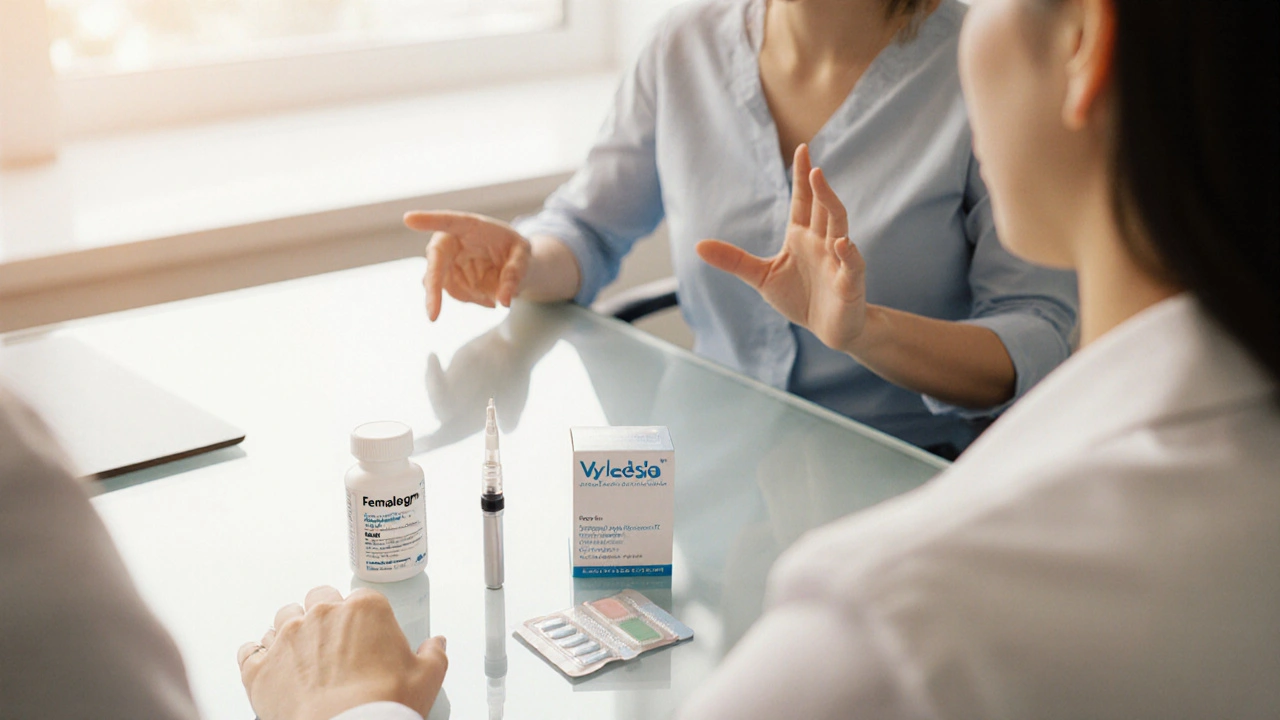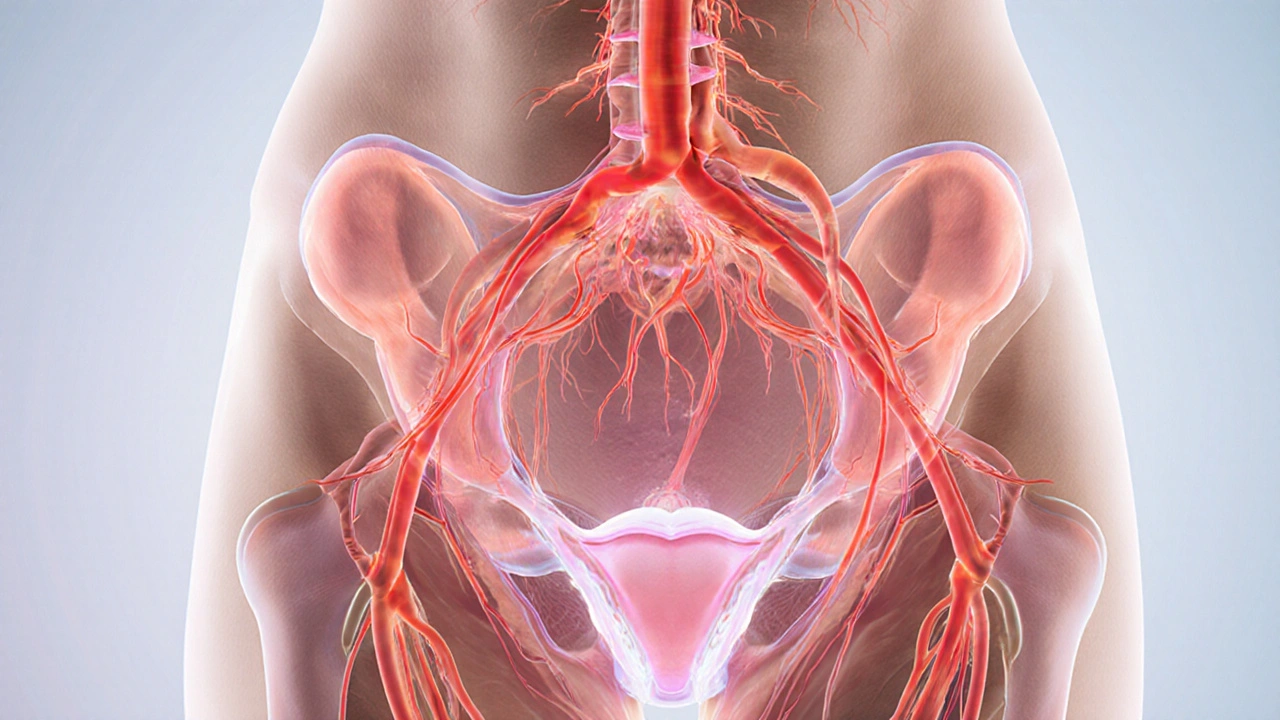Femalegra vs. Other Female Sexual Health Options - Comparison Tool
Use this tool to compare key features of Femalegra with other FDA-approved and off-label treatments for female sexual dysfunction.
Comparison Results
Choose based on your needs:
- Immediate Response: Femalegra, Viagra, or Cialis (off-label)
- Long-term Desire Boost: Addyi or Vyleesi
- Vascular Issues: PDE5 inhibitors (Femalegra, Viagra, Cialis)
- Hormonal or Mood-Related Issues: Addyi or Vyleesi
When a woman's sexual response is limited by blood‑flow issues, doctors sometimes turn to Femalegra, the brand‑name version of sildenafil formulated for female use. It works by relaxing smooth muscle in the genital tissues, allowing more blood to flow where it matters. This article breaks down how Femalegra stacks up against the most common alternatives, so you can decide which option fits your health profile and lifestyle.
Key Takeaways
- Femalegra is a sildenafil‑based tablet approved in several countries for women with sexual arousal disorder linked to vascular problems.
- Other FDA‑approved drugs for women include Addyi (flibanserin) and Vyleesi (bremelanotide), which target neurochemical pathways rather than blood flow.
- Traditional male PDE5 inhibitors such as Viagra and Cialis are sometimes prescribed off‑label for women, but the evidence is mixed.
- Side‑effect profiles differ: sildenafil‑type drugs can cause headache and flushing, while Addyi often leads to dizziness and low blood pressure.
- Choosing the right treatment depends on the underlying cause (vascular vs. hormonal vs. psychological), existing health conditions, and how quickly you need results.
What Is Femalegra?
Femalegra is a prescription tablet that contains 50mg of sildenafil citrate. Unlike the male version marketed as Viagra, Femalegra is marketed specifically for women with diagnosed sexual arousal disorder (SAD) that stems from inadequate genital blood flow. The drug was first launched in Europe in 2017 and later received approval in several Latin American markets.
How Does It Work?
Sildenafil belongs to the phosphodiesterase‑5 (PDE5) inhibitor class. By blocking the PDE5 enzyme, it preserves cyclic guanosine monophosphate (cGMP), a molecule that relaxes smooth muscle and dilates blood vessels. In women, increased blood flow to the clitoris and vaginal walls can enhance lubrication and sensitivity, potentially improving desire and orgasmic response.

Approved Uses & Dosing
The typical adult dose for Femalegra is one 50mg tablet taken approximately 30-60minutes before sexual activity. Doctors may adjust the dose to 100mg if the lower dose is well tolerated but ineffective. The medication should not be used more than once per day.
Femalegra is approved for:
- Women with diagnosed vascular‑related sexual arousal disorder.
- Post‑menopausal women who experience insufficient genital blood flow despite hormone therapy.
It is not approved for general low libido or for use in pregnant or breastfeeding women.
Alternative Treatments for Female Sexual Dysfunction
When considering alternatives, it helps to group them by mechanism of action.
Neuro‑chemical agents
Addyi (flibanserin) is taken daily at bedtime. It works on serotonin, dopamine, and norepinephrine receptors to boost desire over several weeks. Vyleesi (bremelanotide) is a self‑administered injection used 45 minutes before intimacy; it stimulates melanocortin receptors to enhance arousal.
PDE5 inhibitors (off‑label)
Although not approved for women, doctors sometimes prescribe male‑marketed Cialis (tadalafil) or Viagra (sildenafil) off‑label. Tadalafil has a longer half‑life (up to 36 hours) which can provide a more flexible window.
Hormone‑based options
Topical or systemic estrogen therapy can improve vaginal moisture and elasticity, indirectly supporting sexual comfort. In some cases, combined estrogen‑testosterone patches are used for post‑menopausal women with low libido.
Lifestyle & counseling
Regular aerobic exercise, stress‑reduction techniques, and couples counseling have proven benefits for many women. These non‑pharmacologic approaches are usually recommended as first‑line or adjunct treatments.
Side‑Effect & Safety Snapshot
Understanding the risk profile helps you match a drug to your health status.
- Femalegra (sildenafil): headache, flushing, nasal congestion, rare visual disturbances. Contraindicated with nitrates or severe cardiovascular disease.
- Addyi (flibanserin): dizziness, somnolence, low blood pressure, potential interaction with alcohol.
- Vyleesi (bremelanotide): nausea, injection site bruising, transient increase in blood pressure.
- Cialis (tadalafil) off‑label: similar to sildenafil plus possible back pain and muscle aches.
The FDA has issued warnings about using PDE5 inhibitors with nitrate meds because of dangerous drops in blood pressure.
Comparison Table
| Product | Active Ingredient | Typical Dose & Timing | Primary Indication | Onset | Duration | Common Side Effects |
|---|---|---|---|---|---|---|
| Femalegra | Sildenafil citrate | 50mg tablet, 30‑60min before sex | Vascular‑related sexual arousal disorder | 30‑45min | 4‑6hours | Headache, flushing, nasal congestion |
| Viagra (off‑label) | Sildenafil citrate | 50‑100mg tablet, 30‑60min before sex | General female low libido (off‑label) | 30‑45min | 4‑6hours | Same as Femalegra |
| Cialis (off‑label) | Tadalafil | 10‑20mg tablet, up to 36h window | Vascular‑related issues (off‑label) | 30‑60min | Up to 36hours | Back pain, muscle aches, headache |
| Addyi | Flibanserin | 100mg nightly at bedtime | General hypoactive sexual desire disorder | Weeks of daily use | Continuous while dosing | Dizziness, somnolence, low BP |
| Vyleesi | Bremelanotide | 1mg subcutaneous injection, 45min before sex | General hypoactive sexual desire disorder | 45min | 2‑4hours | Nausea, injection site bruising, BP rise |

How to Choose the Right Option
Follow this quick decision flow:
- Identify the primary cause of the problem.
- If a medical exam points to poor genital blood flow, a PDE5 inhibitor (Femalegra, Cialis, Viagra) is the logical first step.
- If low desire appears linked to hormonal changes or mood, consider neuro‑chemical agents (Addyi, Vyleesi) or hormone therapy.
- Check for contraindications.
- Any use of nitrates, uncontrolled hypertension, or recent heart attack rules out sildenafil‑type drugs.
- Severe liver disease or chronic alcohol misuse makes Addyi risky.
- Factor in timing and lifestyle.
- If you need a “on‑demand” effect, Femalegra or Vyleesi are best.
- If you prefer a daily routine and can wait for gradual improvement, Addyi fits.
- Discuss cost and insurance coverage.
- Femalegra is often out‑of‑pocket; generic sildenafil may be cheaper but is off‑label.
- Addyi and Vyleesi have branded pricing; some insurance plans cover them for diagnosed HSDD.
Always have a candid conversation with your clinician about these factors.
How to Get Femalegra
Femalegra requires a prescription from a licensed healthcare provider. The typical pathway looks like this:
- Schedule a visit with a gynecologist, urologist, or a board‑certified sexual health specialist.
- Undergo a basic work‑up: medical history, cardiovascular assessment, and possibly a Doppler ultrasound to confirm reduced genital blood flow.
- If the diagnosis matches, your doctor will write a script for the 50mg tablet. Most pharmacies can order it if it’s not stocked locally.
- Pricing varies by country; in the U.S. the out‑of‑pocket cost can range from $30 to $70 per tablet. Some tele‑medicine platforms offer discounted bulk orders.
Never purchase Femalegra from unverified online sources. Counterfeit pills can contain dangerous contaminants.
Frequently Asked Questions
Is Femalegra safe for women over 60?
Safety data show that older women tolerate the 50mg dose well, provided they have no heart disease or are not using nitrate medications. A lower starting dose is often recommended, and the doctor should monitor blood pressure regularly.
Can I take Femalegra with hormonal estrogen therapy?
Yes, there is no known pharmacokinetic interaction between sildenafil and estrogen. Combining them can address both vascular and hormonal contributors to arousal problems, but the regimen should be overseen by a clinician.
How does the effectiveness of Femalegra compare to Addyi?
Clinical trials report that about 45% of women using Femalegra experience a measurable increase in genital blood flow within hours, while Addyi shows a 30‑35% improvement in desire scores after 4-8 weeks of daily use. The choice hinges on whether you need immediate physical response (Femalegra) or a longer‑term desire boost (Addyi).
Are there any dietary restrictions when taking Femalegra?
A high‑fat meal can delay absorption, pushing the onset from 30 minutes to up to 2 hours. For quickest effect, take the tablet on an empty stomach or after a light snack.
What should I do if I experience a severe headache after the dose?
Mild to moderate headaches are common and usually fade within a few hours. If the pain is severe, persists beyond 4hours, or is accompanied by visual changes, seek medical attention promptly. Your doctor may lower the dose or switch to an alternative.
Next Steps
Start by talking to your healthcare provider about the specific symptoms you’re facing. Bring a list of any medications, especially nitrates or blood‑pressure drugs, because they directly affect whether a PDE5 inhibitor is safe. If the doctor confirms a vascular component, ask whether Femalegra is available in your region or if a generic sildenafil off‑label prescription is an option. For broader desire issues, request a trial of Addyi or Vyleesi and compare results after a few weeks.
Remember, sexual health is multidimensional. Combining medication with lifestyle tweaks-regular cardio, stress management, and open communication with your partner-often yields the best, most sustainable outcomes.

Leah Robinson
October 8, 2025 AT 19:17Hey folks, great info here! If you’re curious, start with a simple doc visit and see if a vascular check is recommended 😊. Small steps lead to big confidence gains.
Abhimanyu Lala
October 13, 2025 AT 00:47Wow this is sooo overblown lol
Richard Sucgang
October 17, 2025 AT 06:17While the comparative table is thorough, one must acknowledge that the clinical methodology behind the cited efficacy percentages lacks uniformity across studies. Moreover, the pharmacodynamic profiles of sildenafil versus flibanserin present divergent pathways that merit distinct safety considerations. The omission of long‑term adherence data for Addyi is a conspicuous gap, particularly when evaluating patient‑centred outcomes. In addition, the article fails to address potential off‑label insurance ramifications, which could impact real‑world accessibility.
Russell Martin
October 21, 2025 AT 11:47Quick tip: if you’re on nitrates, skip the PDE5 stuff – it can cause serious BP drops. Also, take Femalegra on an empty stomach for fastest onset.
Jenn Zee
October 25, 2025 AT 17:17It is profoundly disheartening to witness the rampant commodification of women’s sexual health, reduced to a spreadsheet of side‑effects and onset times. The discourse presented in the article perpetuates a reductive, biomedical paradigm that neglects the sociocultural dimensions of desire and intimacy. By foregrounding pharmacology without robust discussion of relational dynamics, the piece subtly endorses a therapeutic nihilism that blames the individual rather than interrogating systemic pressures. Moreover, the selective citation of studies that favour PDE5 inhibitors betrays an underlying bias, perhaps fueled by industry sponsorship, which is left conspicuously unaddressed. The moral imperative here is to champion a more holistic, patient‑centred approach that integrates counseling, lifestyle modification, and, when appropriate, hormonal therapy. In this vein, the omission of detailed guidance on non‑pharmacologic interventions-such as mindfulness‑based sexual therapy or couple’s communication workshops-represents a glaring oversight. The article’s assertion that “immediate response” is paramount discounts the lived reality of many women who prioritize sustained desire over fleeting physiological changes. Additionally, the safety profile discussion lacks depth; the nuance of contraindications, especially concerning cardiovascular comorbidities, deserves more than a cursory bullet list. The casual mention of “headache” and “flushing” trivializes potential adverse events that can be debilitating for certain patients. It is also worth noting that the cost considerations are treated as an afterthought, yet financial barriers are a primary determinant of treatment adherence. Finally, the piece fails to acknowledge the ethical concerns surrounding off‑label prescribing of male PDE5 inhibitors to women, an area fraught with regulatory ambiguities. In sum, while the comparative table offers a convenient snapshot, it should be situated within a broader, ethically informed, and patient‑empowering narrative.
don hammond
October 29, 2025 AT 22:47Oh sure, because a 45‑minute injection is exactly what everyone wants 🙄💉. Maybe next they’ll market a unicorn‑shaped pill for instant bliss.
Ben Rudolph
November 3, 2025 AT 04:17Seems like they missed the point entirely.
Ian Banson
November 7, 2025 AT 09:47Honestly, it’s a bit of a shame that UK doctors are still stuck on old‑school meds while other countries move ahead. We know the facts, we just need to push for better options.
marcel lux
November 11, 2025 AT 15:17I appreciate the thoroughness of the comparison. Perhaps adding a brief FAQ could help readers quickly find the most relevant info.
Charlotte Shurley
November 15, 2025 AT 20:47The article could benefit from a section on lifestyle and counseling approaches, as these are often first‑line interventions.
Steph Hooton
November 20, 2025 AT 02:17While the data presented is comprehensive, I would like to point out a few typographical errors that could affect readability. Nonetheless, the overall structure is commendable, and the emphasis on individualized treatment aligns well with best practices.
James Waltrip
November 24, 2025 AT 07:47One must question the hidden agendas lurking beneath the glossy veneer of these pharmaceutical endorsements; the narrative subtly advances a capitalist agenda that commodifies intimacy, cloaked in the guise of scientific progress.
Chinwendu Managwu
November 28, 2025 AT 13:17Funny how they claim "immediate response" is the holy grail 😆. Meanwhile, many of us just want a calm, steady vibe. 🤔